Pig Farm Financial Model
This 5-Year, 3-Statement Pig Farm Financial Model in Excel includes revenue streams from Subscription to one-time set-up fees and consulting. Financial statements to forecast the financial health of your Pig Farming business.
Financial Model for a Pig Farm
This financial model for a Pig Farm includes projections for revenue, expenses, and profitability based on various revenue streams. The key financial statements in the model include:
- Income Statement (Profit & Loss)
- Cash Flow Statement
- Balance Sheet
Income Statement
The Income Statement (or Profit and Loss Statement) summarizes the revenues, costs, and expenses incurred during a specific period, typically a year. It shows the profitability of the pig farm.
Key Components:
Revenue:
Sales of Pigs: Revenue from selling pigs (e.g., weaners, growers, finishers, or breeding stock).
Sales of By-products: Revenue from selling manure, biogas, or other by-products.
Other Income: Grants, subsidies, or other farm-related income.
Cost of Goods Sold (COGS):
Feed Costs: Cost of feed for pigs (largest expense for most pig farms).
Veterinary and Medication Costs: Vaccinations, antibiotics, and other health-related expenses.
Breeding Costs: Cost of purchasing or maintaining breeding stock.
Labor Costs: Wages for farm workers.
Utilities: Electricity, water, and heating for the farm.
Other Direct Costs: Transportation, slaughtering fees, etc.
Gross Profit:
Gross Profit = Revenue – COGS
Operating Expenses:
Administrative Costs: Office supplies, accounting fees, etc.
Marketing and Sales Costs: Advertising, market fees, etc.
Depreciation: Depreciation of farm assets (e.g., buildings, equipment).
Repairs and Maintenance: Maintenance of facilities and equipment.
Operating Profit:
Operating Profit = Gross Profit – Operating Expenses
Non-Operating Items:
Interest Expense: Interest on loans or financing.
Other Income/Expenses: Gains or losses from asset sales, insurance payouts, etc.
Net Profit:
Net Profit = Operating Profit + Non-Operating Income – Non-Operating Expenses
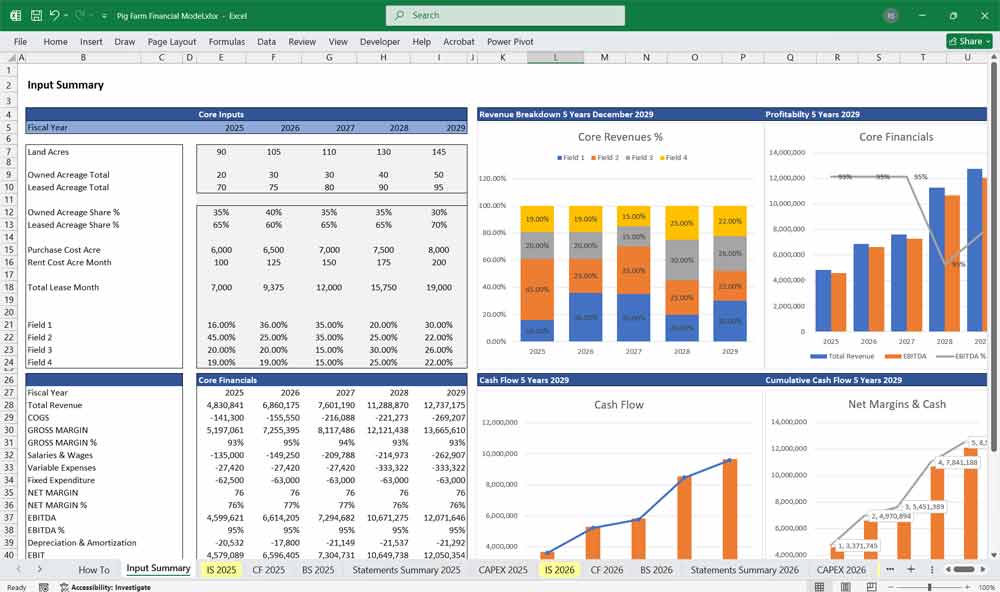
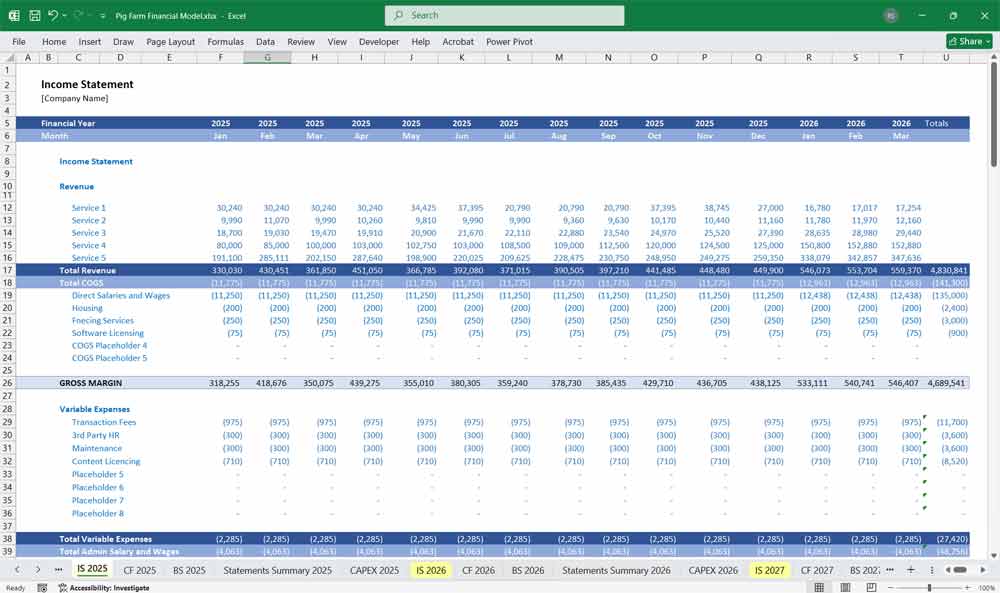
Pig Farm Cash Flow Statement
The Cash Flow Statement tracks the inflows and outflows of cash over a specific period. It is divided into three sections: operating activities, investing activities, and financing activities.
Key Components:
Cash Flow from Operating Activities:
Cash Inflows:
Sales of pigs and by-products.
Subsidies or grants received.
Cash Outflows:
Payments for feed, labor, utilities, and other operating expenses.
Veterinary and medication costs.
Taxes paid.
Cash Flow from Investing Activities:
Cash Inflows:
Proceeds from the sale of farm assets (e.g., equipment, land).
Cash Outflows:
Purchase of new assets (e.g., pig pens, machinery, vehicles).
Capital expenditures for farm expansion or upgrades.
Cash Flow from Financing Activities:
Cash Inflows:
Loans or equity investments received.
Cash Outflows:
Repayment of loan principal.
Payment of dividends (if applicable).
Net Change in Cash:
Net Change in Cash = Cash Flow from Operating Activities + Cash Flow from Investing Activities + Cash Flow from Financing Activities
Closing Cash Balance:
Closing Cash Balance = Opening Cash Balance + Net Change in Cash
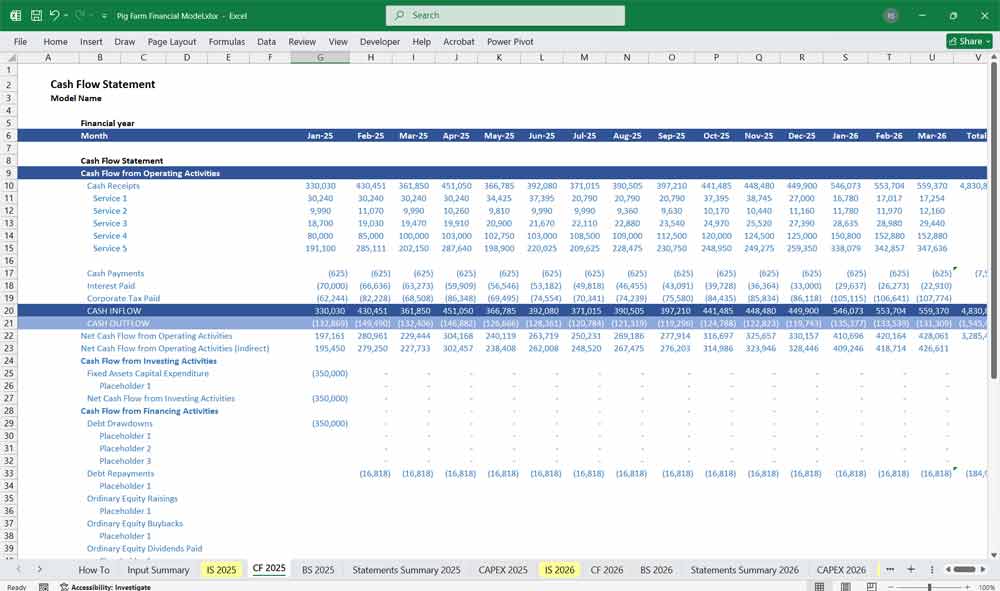
Pig Farm Balance Sheet
The Balance Sheet provides a snapshot of the farm’s financial position at a specific point in time, showing assets, liabilities, and equity.
Key Components:
Assets:
Current Assets:
Cash and cash equivalents.
Accounts receivable (if pigs are sold on credit).
Inventory (e.g., feed, pigs ready for sale).
Non-Current Assets:
Land and buildings (pig pens, storage facilities).
Machinery and equipment (tractors, feeders, etc.).
Breeding stock (sows, boars).
Liabilities:
Current Liabilities:
Accounts payable (e.g., unpaid feed or utility bills).
Short-term loans or credit lines.
Non-Current Liabilities:
Long-term loans (e.g., for land or equipment purchases).
Equity:
Owner’s Equity: Initial investment and retained earnings.
Retained Earnings: Accumulated profits reinvested in the farm.
Balance Sheet Equation:
Assets = Liabilities + Equity
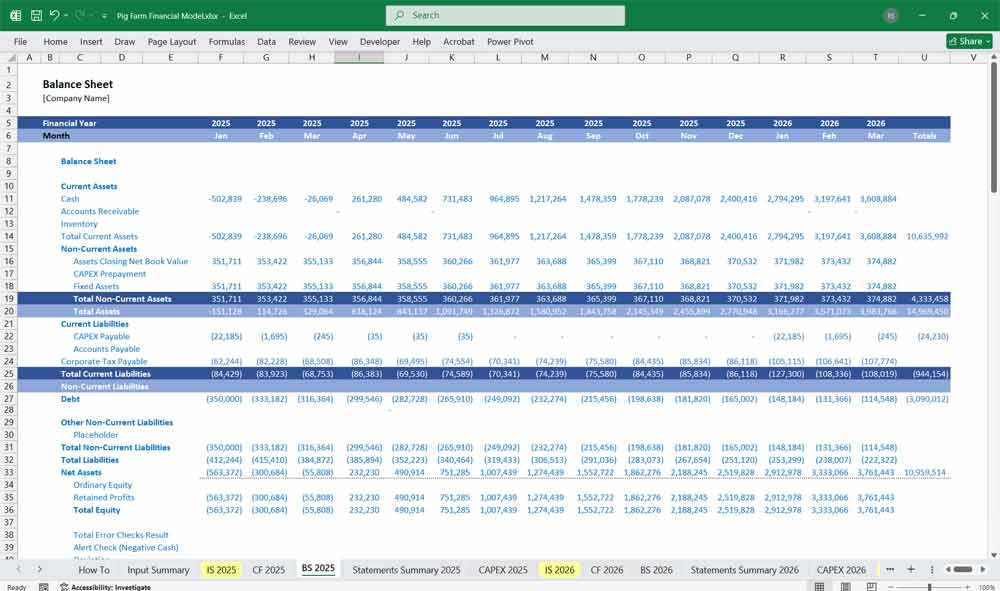
Pig Farming Assumptions and Key Drivers
To build the financial model, you need to make assumptions about key drivers:
Pig Farm Production Volume:
1. Pig Breeding & Genetics
Select high-quality breeding stock for better litter size and growth rates.
Use artificial insemination (AI) to improve genetic quality.
Maintain a proper sow-to-boar ratio for efficient reproduction.
2. Pig Herd Health Management
Implement a strict vaccination and deworming schedule.
Monitor for common diseases (ASF, PRRS, swine flu) and isolate sick pigs.
Work with a veterinarian for regular health checks.
3. Pig Farm Nutrition & Feeding
Provide balanced feed (protein, energy, vitamins, minerals) for each growth stage.
Use automated feeders to reduce waste and ensure consistent feeding.
Monitor feed conversion ratio (FCR) to optimize costs.
4. Pig Farm Housing & Environment
Ensure proper ventilation to prevent respiratory issues.
Maintain optimal temperature (avoid heat stress in summer, cold stress in winter).
Keep pens clean to reduce disease risk and improve growth.
5. Pig Farm Production Monitoring & Record-Keeping
Track key metrics:
Litter pig size & survival rate
Average daily gain (ADG)
Feed efficiency (FCR)
Mortality rate
Use farm management software for data analysis.
6. Pig Farm Weaning & Growth Management
Follow a structured weaning process (3-4 weeks).
Separate pigs by size to reduce competition.
Implement all-in/all-out (AIAO) systems to minimize disease spread.
7. Pig Farm Marketing & Sales Strategy
Identify target markets (live pigs, processed meat, exports).
Build relationships with buyers, processors, and distributors.
Adjust production based on market demand and pricing trends.
8. Pig Farm Cost Control & Profitability
Optimize feed costs (bulk purchasing, alternative ingredients).
Reduce mortality and cull non-performing animals early.
Invest in labor efficiency (training, automation).
9. Pig Farm Biosecurity Measures
Restrict farm access to prevent disease outbreaks.
Implement foot baths, vehicle disinfection, and rodent control.
Quarantine new stock before introducing them to the herd.
10. Pig Farm Sustainability & Waste Management
Utilize manure for biogas or organic fertilizer.
Follow environmental regulations to avoid pollution.
Implement water-saving techniques in cleaning and feeding.
Pig Farm Pricing
1. Cost-Based Pricing
Calculate production costs (feed, labor, medicine, housing, utilities).
Include fixed costs (depreciation, loan interest, salaries).
Add a profit margin (typically 15-30%) to ensure sustainability.
2. Pig Farm Market-Based Pricing
Monitor local and global pork prices (demand-supply trends).
Adjust prices based on competitor pricing in your region.
Consider seasonal demand (higher prices during festivals, holidays).
3. Pig Farm Value-Based Pricing
Charge premium prices for high-quality breeds (e.g., organic, free-range, antibiotic-free).
Offer differentiated products (special cuts, processed pork, branded meat).
Target niche markets (hotels, restaurants, high-end butchers).
4. Pig Farm Pricing by Weight & Grade
Live weight pricing (per kg based on market rates).
Carcass weight pricing (after slaughter, based on meat yield).
Grade-based pricing (lean meat percentage, fat content).
5. Pig Farm Contract Pricing
Negotiate long-term contracts with processors or supermarkets for stable income.
Use forward pricing (agree on future prices to hedge against market drops).
Offer volume discounts for bulk buyers.
6. Pig Farm Dynamic Pricing Strategies
Adjust prices based on real-time market fluctuations.
Offer promotional pricing for excess pig farm stock or slow-moving inventory.
Use auction systems (if selling through livestock markets).
7. Pricing for Different Stages
Weaners (piglets) – Price based on breed, health, and weight.
Growers/Finishers – Price per kg with discounts for large orders.
Sows & Boars (breeding stock) – Higher prices for proven genetics.
8. Pig Farm Discounts & Incentives
Offer early payment discounts to encourage quick sales.
Provide loyalty discounts for repeat buyers.
Bundle products (e.g., selling pork cuts with offal at a package rate).
9. Export Pricing Considerations
Factor in transportation, tariffs, and certification costs.
Align with international pork price benchmarks (e.g., Chicago Mercantile Exchange).
Adjust for currency exchange rates if selling abroad.
10. Record & Analyze Pricing Performance
Track sales data to identify profitable pricing models.
Compare profit margins across different buyers and markets.
Adjust strategies based on customer feedback and market trends.
Pig Farm Costs:
Feed cost per pig.
Labor cost per pig.
Veterinary and medication costs per pig.
Pig Farm Capital Expenditures:
1. Land & Infrastructure
Purchase or lease land (consider soil quality, drainage, and expansion potential).
Fencing & security (perimeter fencing, gates, surveillance).
Roads & drainage systems (for accessibility and flood prevention).
2. Pig Farm Housing & Facilities
Construction of pig pens/sheds (materials, ventilation, flooring).
Farrowing crates (for sows and piglets).
Weaning & growing pens (adjustable for different age groups).
Feed storage silos & warehouses (to prevent spoilage and pests).
3. Pg Farm Equipment & Machinery
Automatic feeders & waterers (reduce labor costs and waste).
Ventilation systems (fans, heaters, cooling pads).
Waste management systems (biogas plants, slurry pumps, composters).
Loading ramps & transport equipment (for moving pigs efficiently).
4. Pig Farm Breeding & Genetic Investments
High-quality breeding stock (sows, boars, or AI technology).
Semen storage & AI equipment (if using artificial insemination).
Genetic testing & performance tracking software.
5. Pig Farm Biosecurity & Health Infrastructure
Quarantine zones (for new or sick animals).
Disinfection systems (foot baths, vehicle sprayers).
Veterinary clinic & medication storage.
6. Pig Farm Feed Production & Processing
Feed mills & mixers (if producing feed on-site).
Grain storage & drying facilities (to maintain feed quality).
Feed delivery systems (conveyor belts, augers).
7. Pig Farm Technology & Automation
Farm management software (tracking growth, feed, health).
Climate control systems (automated temperature regulation).
RFID or ear tag systems (for individual pig tracking).
8. Pig Farm Utilities & Energy
Water supply & boreholes (ensure consistent clean water).
Solar/wind energy systems (reduce electricity costs).
Backup generators (for power outages).
9. Pig Farm Transportation & Logistics
Livestock trucks/trailers (for transporting pigs to market).
Cold storage facilities (if selling processed meat).
10. Expansion & Future-Proofing
Reserve funds for scaling up (additional pig farm pens, new technology).
Compliance upgrades (meeting new environmental/health regulations).
Budgeting & Financing Tips
Prioritize ROI-driven investments (e.g., automation to cut labor costs).
Explore grants/subsidies for sustainable farming practices.
Lease vs. buy analysis for high-cost machinery.
Pig Farm Financing:
Interest rates on loans.
Repayment schedules.
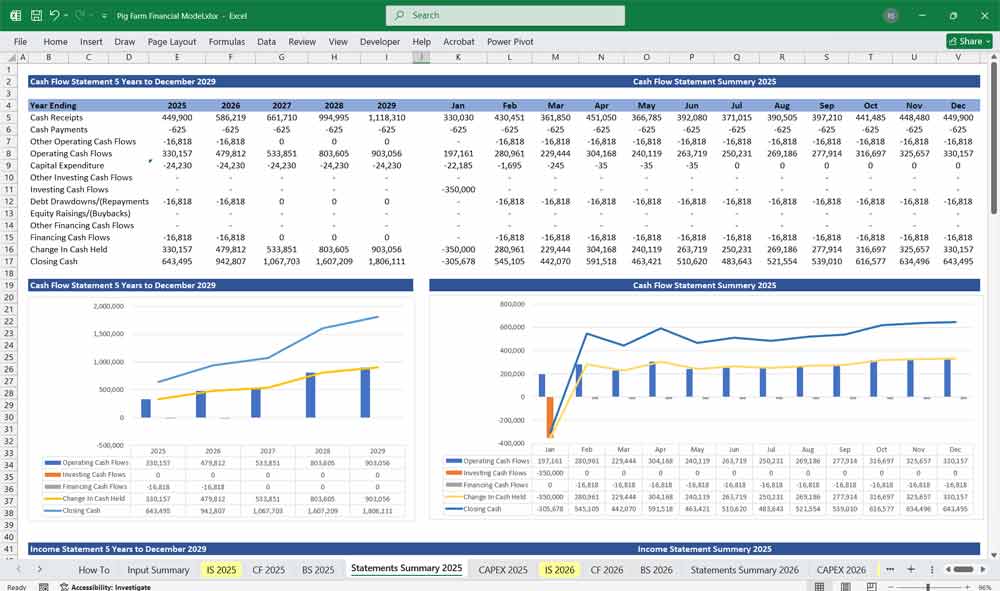
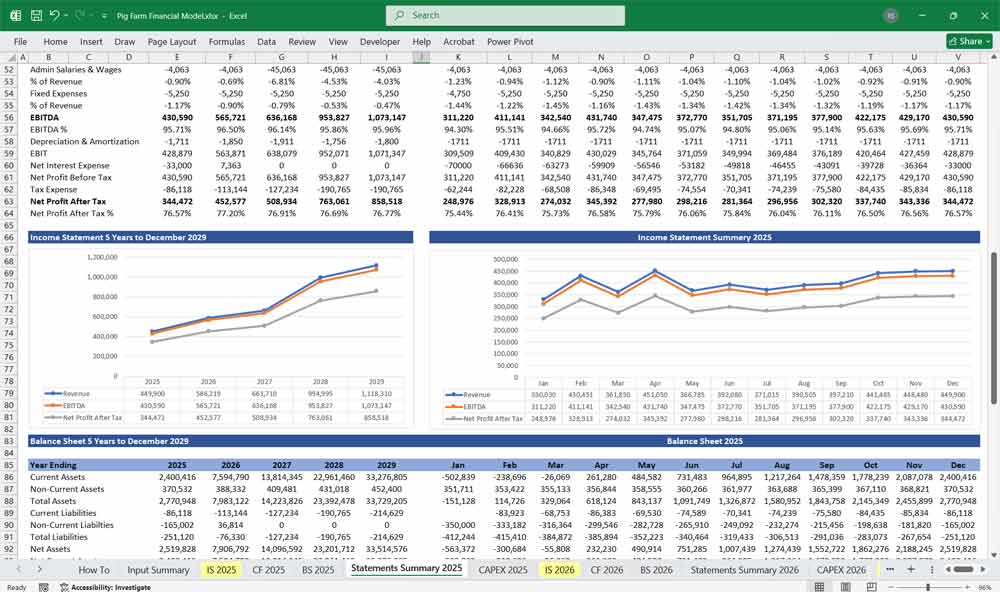



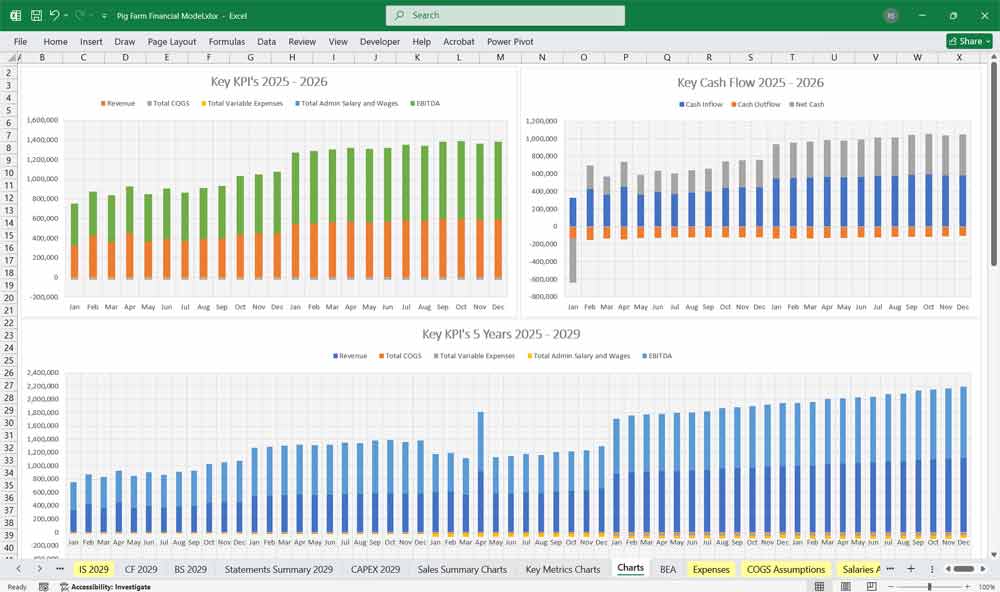
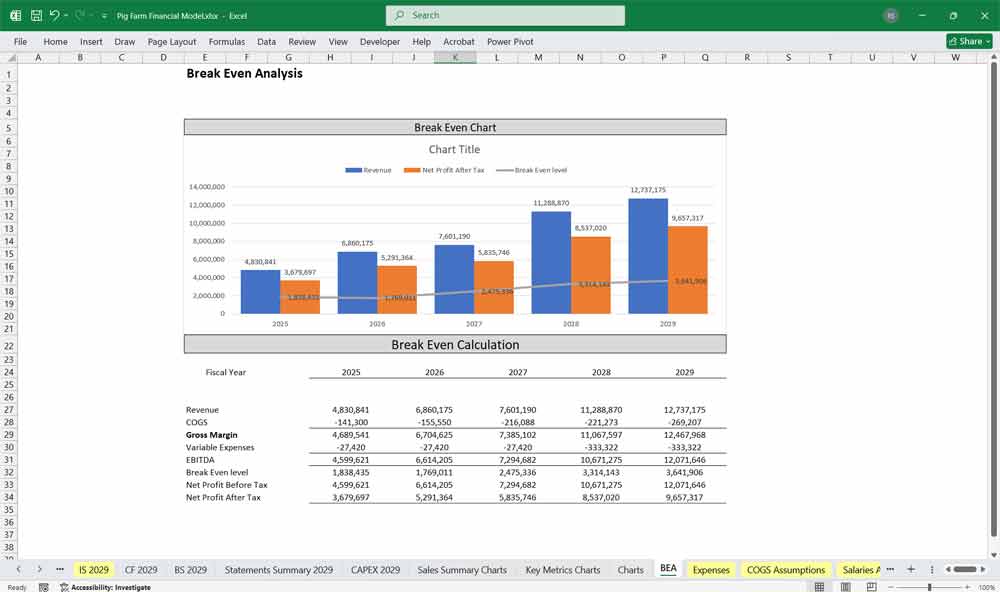
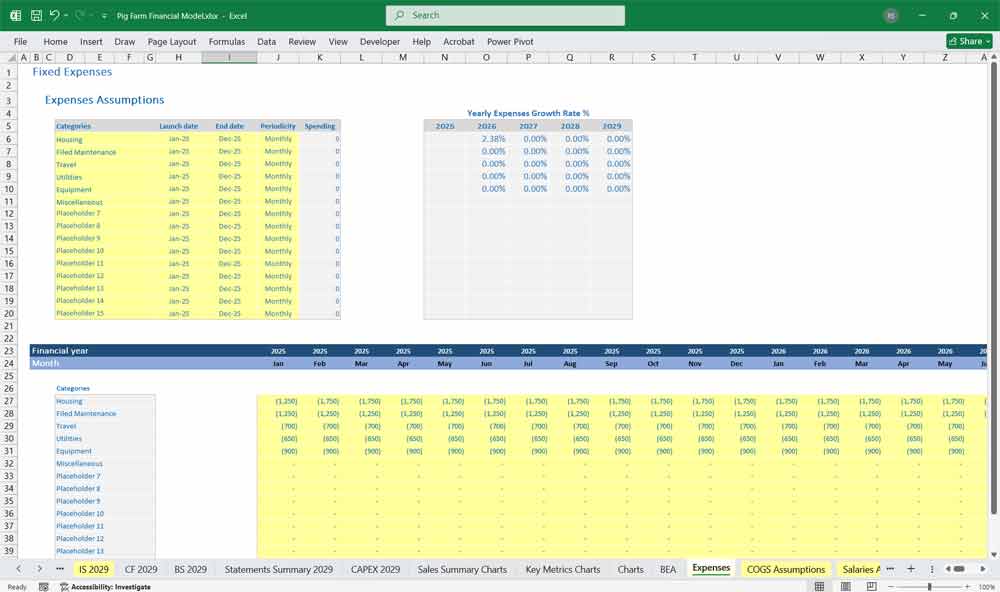
Conclusion on the Financial Model
This financial model for a pig farm helps in understanding the profitability, cash flow, and financial health of the business. It requires accurate assumptions about production, pricing, and costs. Regularly updating the model with actual performance data ensures better decision-making and long-term sustainability.
Download Link On Next Page
